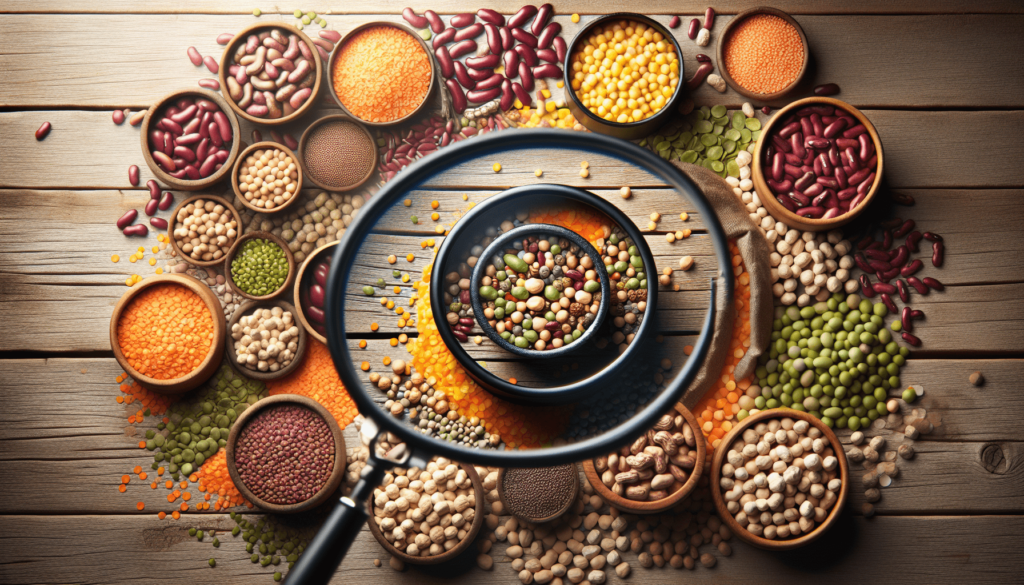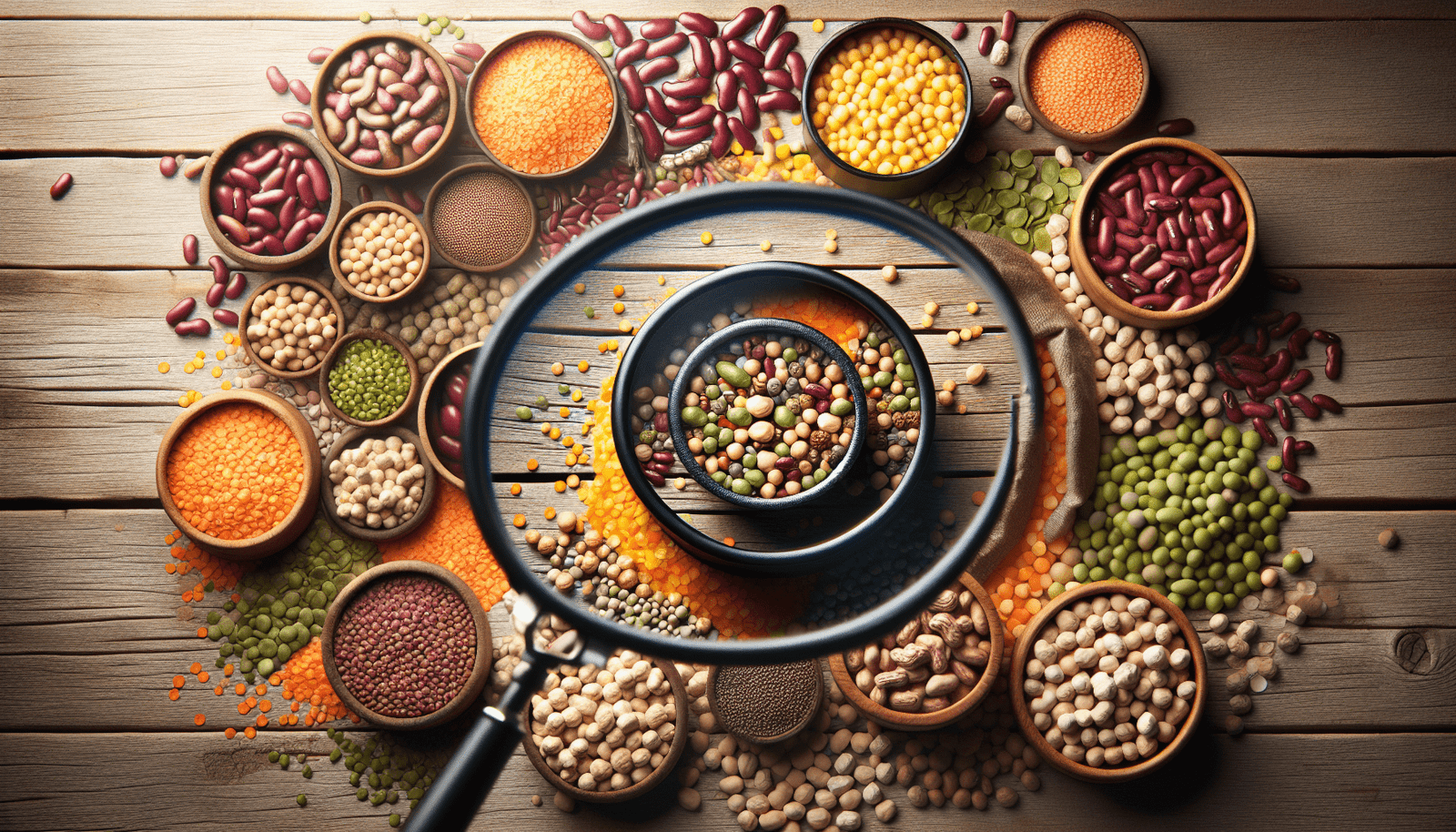Legumes have long been recognized for their nutritional value and health benefits, but did you know that certain legumes contain prebiotic fibers that are especially beneficial for our gut bacteria? In this article, we will explore the legumes that are rich in these prebiotic fibers and how they can contribute to a healthier digestive system. So if you’re curious about improving your gut health and are ready to discover which legumes to incorporate into your diet, read on!

Introduction to Prebiotic Fibers
Definition of prebiotics
Prebiotics are a type of dietary fiber that are indigestible by humans but serve as a food source for beneficial gut bacteria. Unlike probiotics, which are live bacteria and yeasts that are beneficial for our health, prebiotics are non-living substances that help promote the growth and activity of these beneficial bacteria in our gut.
Importance of prebiotic fibers for gut health
Maintaining a healthy gut is essential for overall well-being. The gut is home to trillions of bacteria, collectively known as the gut microbiome, which play a crucial role in digestion, immune function, and even mental health. Prebiotic fibers are important because they act as a fuel source for the beneficial bacteria in our gut, helping them to multiply and thrive. By promoting the growth of these bacteria, prebiotic fibers help maintain a healthy balance in the gut microbiome and support optimal gut health.
The Role of Gut Bacteria
Overview of gut bacteria
The human gut is host to a vast number of bacterial species, collectively known as the gut microbiome. These bacteria perform numerous functions, including the breakdown of complex carbohydrates and the synthesis of certain vitamins. They also play a crucial role in maintaining a healthy immune system and protecting against harmful pathogens.
Importance of maintaining a healthy gut microbiome
A healthy gut microbiome is essential for overall health and well-being. Imbalances or disruptions in the gut microbiome have been linked to a range of health issues, including digestive disorders, allergies, obesity, and even mental health conditions such as depression and anxiety. Therefore, it is crucial to nourish and support our gut bacteria to maintain a healthy gut microbiome.
What are Legumes?
Definition and types of legumes
Legumes are a family of plants that includes beans, lentils, chickpeas, and peas. They are rich in nutrients such as protein, fiber, vitamins, and minerals. Legumes come in various shapes, sizes, and colors and are consumed worldwide for their taste, versatility, and health benefits.
Nutritional value of legumes
Legumes are packed with nutrients that are important for our overall health. They are a rich source of plant-based protein, making them an excellent choice for vegetarians and vegans. Legumes are also high in dietary fiber, which promotes regular bowel movements and helps maintain a healthy digestive system. Additionally, legumes contain vitamins, such as folate, and minerals, such as iron and potassium, which are essential for various bodily functions.
Prebiotic Fibers in Legumes
Common prebiotic fibers found in legumes
Legumes are a fantastic source of prebiotic fibers, which nourish the beneficial bacteria in our gut. Some of the common prebiotic fibers found in legumes include oligosaccharides, resistant starch, and non-digestible carbohydrates. These fibers are not broken down during digestion, allowing them to reach the colon where they can be fermented by the beneficial bacteria.
How prebiotic fibers promote gut health
When prebiotic fibers are fermented by the gut bacteria, they produce short-chain fatty acids (SCFAs) such as acetate, propionate, and butyrate. These SCFAs provide a source of energy for the cells lining the colon and help maintain their health and integrity. SCFAs also have anti-inflammatory effects, enhance nutrient absorption, and play a role in regulating the immune system. By promoting the growth of beneficial gut bacteria and the production of SCFAs, prebiotic fibers support gut health.

Benefits of Prebiotic Fibers for Gut Bacteria
Improved digestion and nutrient absorption
The consumption of prebiotic fibers from legumes can help improve digestion and nutrient absorption. The fermentation of these fibers by gut bacteria produces enzymes that aid in the breakdown of complex carbohydrates, proteins, and fats, making them more easily digestible. This can enhance nutrient absorption and ensure that we get the most out of the food we eat.
Increased population and diversity of beneficial gut bacteria
Including prebiotic fiber-rich legumes in your diet can increase the population and diversity of beneficial gut bacteria. As these fibers reach the colon, they provide a food source for the beneficial bacteria, allowing them to multiply and thrive. A healthy population of beneficial gut bacteria is essential for optimal gut health and overall well-being.
Legumes Rich in Prebiotic Fibers
Chickpeas
Chickpeas, also known as garbanzo beans, are a versatile legume that is rich in prebiotic fibers. They are a staple ingredient in various cuisines and can be used to make delicious dishes such as hummus and falafel. Chickpeas are also a good source of plant-based protein, vitamins, and minerals, making them an excellent addition to a balanced diet.
Lentils
Lentils are a type of legume that comes in various colors, including green, brown, and red. They are high in both protein and fiber, making them a nutritious choice for vegetarians and vegans. Lentils are also a good source of folate, iron, and potassium. They can be used in a variety of dishes, including soups, stews, and salads.
Kidney beans
Kidney beans are another legume that is rich in prebiotic fibers. They are named for their shape, which resembles that of a kidney. Kidney beans are known for their high fiber content, which helps promote digestive regularity. They are also a good source of plant-based protein, folate, and iron. Kidney beans are commonly used in chili, salads, and other savory dishes.
Black beans
Black beans have a dense, meaty texture and a rich, earthy flavor. They are an excellent source of prebiotic fibers, protein, and antioxidants. Black beans also provide vitamins and minerals, such as folate, magnesium, and potassium. They can be used in a variety of recipes, including soups, stews, and vegetarian burgers.
Pinto beans
Pinto beans are a popular legume commonly used in Mexican and Southwestern cuisine. They have a creamy texture and a mild, earthy flavor. Pinto beans are a good source of prebiotic fibers, protein, folate, and iron. They can be used in dishes such as burritos, tacos, and chili.
Navy beans
Navy beans, also known as haricot beans, are small, white legumes that are rich in prebiotic fibers. They have a mild, slightly nutty flavor and a creamy texture when cooked. Navy beans are a good source of protein, fiber, and various vitamins and minerals. They are commonly used in soups, stews, and baked bean dishes.
Preparation and Consumption Tips
Soaking and cooking methods
Before cooking legumes, it is recommended to soak them to reduce cooking time and improve digestibility. To soak legumes, simply place them in a bowl, cover with water, and let them soak overnight. You can also use the quick-soaking method by bringing them to a boil, then letting them sit for an hour. After soaking, rinse the legumes and cook them according to your preference. Cooking methods can include boiling, pressure cooking, or using a slow cooker.
Incorporating legumes into everyday meals
Legumes can be easily incorporated into everyday meals for added nutrition and prebiotic fiber. They can be used in a variety of dishes, including soups, stews, salads, and even desserts. Try adding chickpeas to your salads, lentils to your soups, or black beans to your tacos. Legumes can also be pureed to make dips, spreads, or even brownies. The possibilities are endless, and adding legumes to your meals is a simple and delicious way to boost your intake of prebiotic fibers.
Other Sources of Prebiotic Fibers
Fruits and vegetables
In addition to legumes, fruits and vegetables are also excellent sources of prebiotic fibers. Bananas, onions, garlic, asparagus, and Jerusalem artichokes are just a few examples of prebiotic fiber-rich foods. Including a variety of fruits and vegetables in your diet can help support a healthy gut microbiome and overall gut health.
Whole grains
Whole grains, such as oats, barley, and quinoa, also contain prebiotic fibers. These fibers are found in the outer layers of the grain, which are retained in whole grain products. Incorporating whole grains into your diet can provide a good source of prebiotic fibers while also providing important nutrients.
Nuts and seeds
Nuts and seeds, such as almonds, flaxseeds, and chia seeds, are not only nutritious but also rich in prebiotic fibers. Including a variety of nuts and seeds in your diet can provide a source of healthy fats, protein, and prebiotic fibers, all of which support gut health.
Potential Side Effects of Legume Consumption
Flatulence and digestive discomfort
Legumes are known for causing flatulence and digestive discomfort in some individuals. This is due to their high fiber content, which can be difficult for some people to digest. However, these side effects can be minimized by gradually increasing legume consumption, soaking and cooking legumes properly, and incorporating other prebiotic fiber-rich foods into the diet.
Reducing side effects through proper preparation and cooking
To reduce the side effects of flatulence and digestive discomfort associated with legume consumption, it is important to properly prepare and cook legumes. Soaking legumes before cooking and using cooking methods that help break down the fibers can make legumes easier to digest. It is also beneficial to cook legumes thoroughly and chew them well to aid in digestion.
Conclusion
Importance of including legumes in a balanced diet
Legumes are not only a delicious and versatile addition to meals but also a valuable source of prebiotic fibers beneficial for gut bacteria. Including legumes in a balanced diet can help promote a healthy gut microbiome and support optimal gut health. By nourishing the beneficial bacteria in our gut, legumes contribute to improved digestion, nutrient absorption, and overall well-being.
Promoting gut health through prebiotic fiber-rich legumes
The role of prebiotic fibers in supporting gut health cannot be overstated. Legumes, such as chickpeas, lentils, kidney beans, black beans, pinto beans, and navy beans, are rich in prebiotic fibers that aid in maintaining a healthy gut microbiome. By consuming these legumes and incorporating them into our everyday meals, we can support the growth and activity of beneficial gut bacteria, improve digestion and nutrient absorption, and enhance our overall gut health. So why not introduce more legumes into your diet and give your gut the love and care it deserves?

